While Tony has been busy in getting the Earthship build organized, Susan was preparing her garden for the time when she would be away from it for a week, as she wants to attend her daughter’s graduation from Lund University in Sweden. As she left this morning, I think it is the perfect time to take a closer look at her plants. Susan won’t mind. In fact, she left with a sense of proud accomplishment, giving us a thorough list of how to take care of it, and even continue its progress if we have some extra time along the Earthship construction… We’ll have to see about that. Though I’m happy to introduce her garden here!
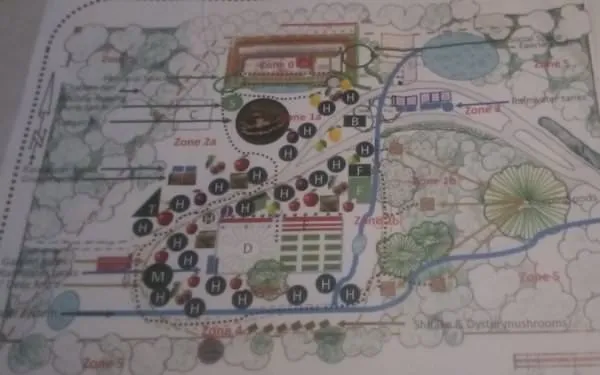
The image above is the design she submitted as part of her PDC at Oregon State University. It is a map of the cleared section of their property, with the Earthship house on the northern edge, and her garden south of it. The H stands for hazelnut guilds, the M for maple guild, while the other trees are indicated by the fruit images. Though it will take way beyond the completion of the build to finalize her design, certain elements have already been set in place.
Sheet-mulching and Hügel Culture
Uncovered soil tends to dry out very quickly, lose nutrients, and foster an endless battle with weeds. It is therefor a surprise to me that not everyone mulches their gardens regularly. A layer of leaves already does a lot, but mulching can be taken up to many higher levels, using cardboard, newspaper, straw, wood-chips, lawn-clippings, bark, etc. Cover a large area with thin layers of these materials, along with ripe compost and/or manure in between, and you have created a sheet-mulched bed, also known as “lasagna gardening”. This way soil is created while plants grow in it. The layers will decompose gradually, releasing nutrients little by little, which the growing veggies will be happy to use. Susan widely follows this technique, but it is by far not the only type of mulching she does.
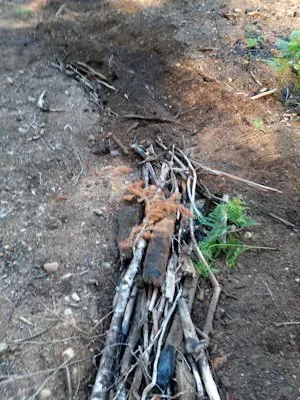

Living in a place where lots of wood is being processed, she also makes use of the endless supply of sawdust, wood-chips, bark, and most of all tangles of roots that couldn’t be put through the chipper. These pieces are buried in a ditch, covered with more sticks and branches, as well as soil. On top of all this she piles sawdust, manure, straw, and finished compost. The hills created this way are called Hügel (meaning “hill” in German). When I was here two years ago, we were proud to build one enormous hill. Since then she has opted for many small Hügels instead. In this one you can see the various layers as it is being built longer instead of wide, tall, and deep.
Herb-Spiral and Potato-Tires
Building the Earthship requires tires, and lots of it. We estimate that it will take about a thousand tires to complete the walls. At this rate, there are really more than enough tires around, to use in other applications, such as planting potatoes. The nice thing about potatoes is that they just keep growing more tubers after being harvested. This may be troublesome if you want to grow other things in the same area. So instead of spreading the potato field wide, one can plant them inside tires. They will contain the plants, and as the potatoes grow taller additional tires can be stacked on top, filled with fresh soil. The leaves and shoots will adapt to the conditions, forming more roots, and thus more potato tubers.
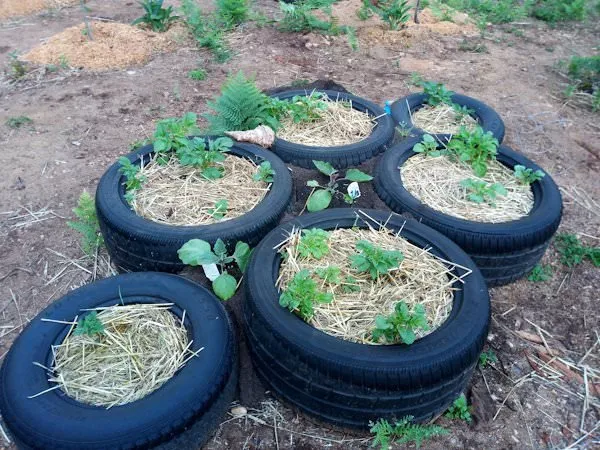
Another interesting technique no Permaculturist can leave untried is the herb-spiral. The idea is straight forward: Certain herbs love the sun and dryer soil, while others thrive in wetter conditions. By placing them in a spiral with an elevated center, one can grow a wide variety of small kitchen herbs in a small space. Ideally, this ingenious structure should be just outside the kitchen, for a quick access to all your favorite fresh herbs. But since the gardens around the house can’t be set up while the construction is still going on, this spiral in the big garden exemplifies beautifully how this nifty Permaculture technique works. I remember creating lots of herb-spirals as a practical part of Permaculture intro-weekends, and can safely say that it doesn’t take much time to set one up. Of course, you want to utilize local material, such as the logs on this site.
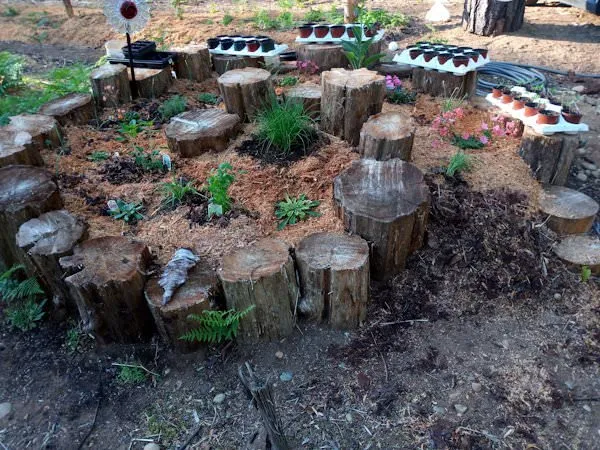
Perennial Poly-cultures
A major part of what Permaculture is about is creating eco-systems. One species alone is weak and susceptible to all kinds of problems. But put into the proper context of a number of trees, bushes, herbs, flowers, insects, birds, etc. the same species can thrive as part of a community of other species. And Susan’s garden is full of such examples. Beneficial “weeds” such as lupine and comfrey fix nitrogen and attract pollinating insects, as well as predators (directly, as well as indirectly, by attracting their food), which keep pests in check. This creates a wonderful environment for fruit trees to grow in, which are really the future of the garden.
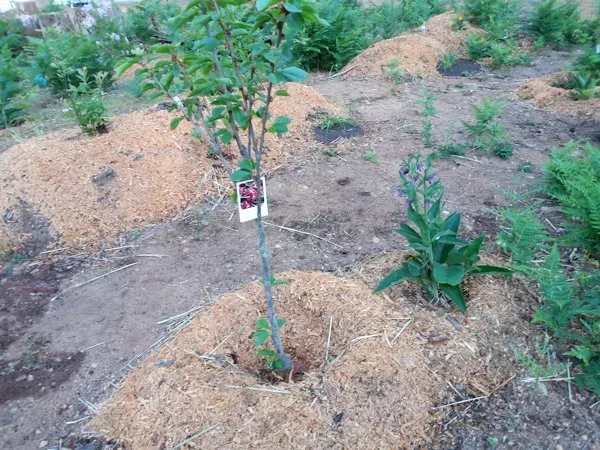
As the garden is being set up, it is geared towards annuals. After all, we want it to grow food for this season, right away. The long-term plan, however, is to focus on perennials, which are being planted at the same time. Sure, the trees will take a few years to mature before we can expect cartloads of apples and cherries. But as they grow, the importance is going to shift gradually away from the annuals, in favor for the perennials.
A type of plant that grows wonderfully in this region is hazelnuts. The variety Susan is using is resistant to the blight that has recently wiped out hazelnut plantations all along the west coast. What’s most exciting about them, however, are the truffles they will be inoculated with. Talking about these wonderfully lucrative fungi...
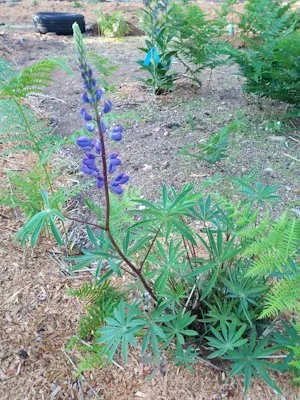
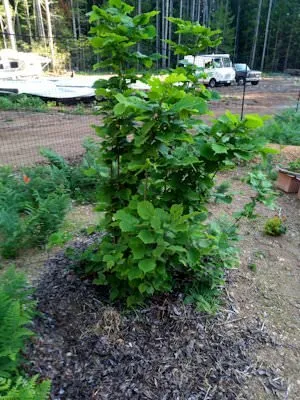
Best of the West: Mushrooms
One of the most prevalent climatic factors on the “wet coast” is the abundant wetness. One would be a fool not trying to make the most of it. And what grows better in these muggy, damp conditions than fungi? Of course you gotta pick the right ones: Susan’s choice are the delicious oyster mushroom, and the even better shiitake. Just recently we took out the inoculated logs from the water they’d been sitting in, and hung them up in a dark and shielded corner of the property. Soon enough they should start producing delicious mushrooms, which will just keep on growing again and again for quite a while.
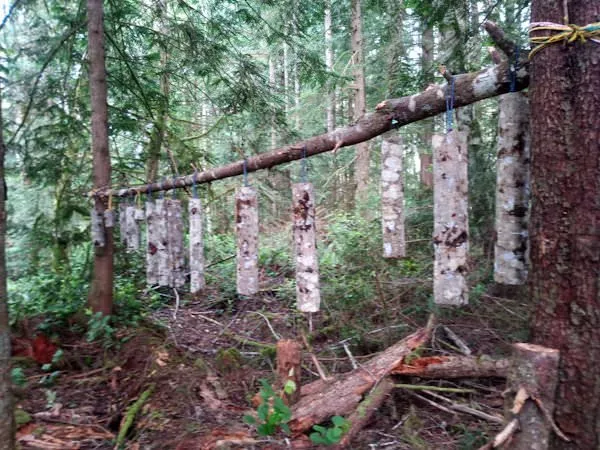
Before closing this introduction to Susan’s garden, I want to mention her most recent entry in her blog. It is worth checking out, as it mentions the ongoing projects, as well as how they relate to the social aspect of Permaculture. Please visit her site if you’re interested, and if you’re in the area stop by to visit or volunteer!
If you are interested in this project, please visit the other posts I have published in my Doighouse Series:
Please check out these great communities I'm contributing to:

#homesteadersonline | Website | Discord Community

#ecotrain | What is EcoTrain | Discord Community

#thankyoubicycle | Introducing Thank You Bicycle

Introducing SteemitDreamit | Facebook Group | Discord Community